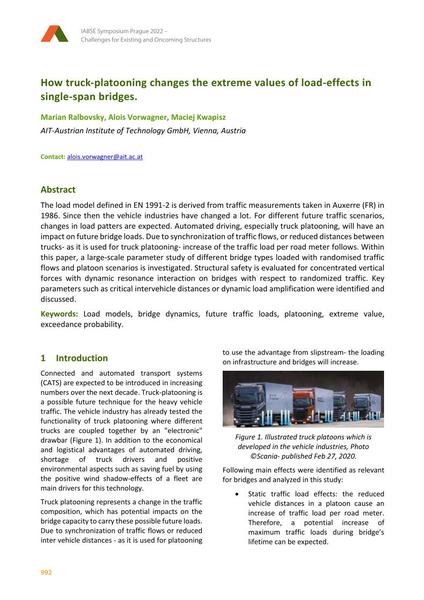How truck-platooning changes the extreme values of load-effects in single-span bridges.

|
|
|||||||||||
Détails bibliographiques
| Auteur(s): |
Marian Ralbovsky
(AIT-Austrian Institute of Technology GmbH, Vienna, Austria)
Alois Vorwagner (AIT-Austrian Institute of Technology GmbH, Vienna, Austria) Maciej Kwapisz (AIT-Austrian Institute of Technology GmbH, Vienna, Austria) |
||||
|---|---|---|---|---|---|
| Médium: | papier de conférence | ||||
| Langue(s): | anglais | ||||
| Conférence: | IABSE Symposium: Challenges for Existing and Oncoming Structures, Prague, Czech Republic, 25-27 May 2022 | ||||
| Publié dans: | IABSE Symposium Prague 2022 | ||||
|
|||||
| Page(s): | 992-999 | ||||
| Nombre total de pages (du PDF): | 8 | ||||
| DOI: | 10.2749/prague.2022.0992 | ||||
| Abstrait: |
The load model defined in EN 1991-2 is derived from traffic measurements taken in Auxerre (FR) in 1986. Since then the vehicle industries have changed a lot. For different future traffic scenarios, changes in load patters are expected. Automated driving, especially truck platooning, will have an impact on future bridge loads. Due to synchronization of traffic flows, or reduced distances between trucks- as it is used for truck platooning- increase of the traffic load per road meter follows. Within this paper, a large-scale parameter study of different bridge types loaded with randomised traffic flows and platoon scenarios is investigated. Structural safety is evaluated for concentrated vertical forces with dynamic resonance interaction on bridges with respect to randomized traffic. Key parameters such as critical intervehicle distances or dynamic load amplification were identified and discussed. |
||||
| Copyright: | © 2022 International Association for Bridge and Structural Engineering (IABSE) | ||||
| License: | Cette oeuvre ne peut être utilisée sans la permission de l'auteur ou détenteur des droits. |
||||
